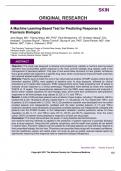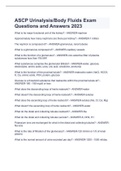SKIN
ORIGINAL RESEARCH
A Machine Learning-Based Test for Predicting Response to
Psoriasis Biologics
Jerry Bagel, MD1, Yipeng Wang, MD, PhD2, Paul Montgomery, III2, Christian Abaya2, Eric
Andrade2, Courtney Boyce2, Tatiana Tomich2, Byung-In Lee, PhD2, David Pariser, MD3, Alan
Menter, MD4, Tobin J. Dickerson, PhD2
1
The Psoriasis Treatment Center of Central New Jersey, East Windsor, NJ
2
Mindera Health, San Diego, CA
3
Eastern Virginia Medical School and Virginia Clinical Research, Inc., Norfolk, VA
4
Baylor University Medical Center, Dallas, TX
ABSTRACT
Objective: This study was designed to develop and prospectively validate a machine learning based
algorithm that could predict patient response to the most common biologic drug classes used in the
management of psoriasis patients. This type of tool would allow clinicians to have greater confidence
that a given patient will respond to a specific drug class, which could lead to improved health outcomes
and reduced wasted healthcare spend.
Methods: Patients were enrolled into one of two observational studies (STAMP studies) where dermal
biomarker patches (DBPs) were applied at baseline prior to drug exposure, followed by clinical
evaluations at 12 weeks after exposure. PASI measurements were made at baseline and 12 weeks to
evaluate clinical response to a clinical phenotype. Responders were defined as those who reached
PASI75 at 12 weeks. The transcriptomes obtained from the DBPs were sequenced and analyzed to
derive and/or validate classifiers for each biologic class, which were then combined to yield predictive
responses for all three biologic drug classes (IL-23i, IL-17i, and TNFi).
Results: A total of 242 psoriasis patients were enrolled in these studies, including 118 patients (49.6%)
treated with IL-23i, 79 patients (33.2%) treated with IL-17i, 35 patients (14.7%) treated with TNFi, and
6 patients (2.5%) treated with IL-12/23i. The IL-23i predictive classifier was developed from the earlier
enrolled patients and independently validated with the latter enrolled patients. IL-17i and TNFi
predictive classifiers were developed using publicly available datasets and independently validated with
patients from the STAMP studies. In the independent validation, positive predictive values for three
classifiers (IL-23i, IL-17i, and TNFi) were 93.1%, 92.3% and 85.7% respectively. Over the entire
cohort, 99.5% of patients were predicted to respond to at least one drug class.
Conclusion: This study demonstrates the power of using baseline dermal biomarkers
and machine learning methods as applied to the prediction of patient response to psoriasis biologics
prior to drug exposure. Using this test, patients, physicians, and the health care system all can benefit
in distinct ways. Precision medicine can be realized for individual patients as most will likely respond to
their prescribed biologic the first time. Physicians can prescribe these drugs with increased confidence,
and the healthcare system will realize lower net costs as well as greatly reduced wasted spend by
significantly improving initial response rates to expensive biologic therapeutics.
November 2021 Volume 5 Issue 6
Copyright 2021 The National Society for Cutaneous Medicine 621
, SKIN
common disease, with approximately 2.8% of
INTRODUCTION
the United States population, or 7.5 million
people, diagnosed with psoriasis. The
The promise of personalized medicine has pathology of the disease has been heavily
been touted for many years but has been studied and is known to be triggered by a
elusive in some specialties.1 Recently, with complex inflammatory circuit that stimulates
the influx of large data sets from “omics”- keratinocyte proliferation via upregulation of
based methods including genomics, a host of cytokines including tumor necrosis
transcriptomics, and metabolomics, factor-alpha (TNF), interleukin (IL)-17, and
personalized approaches to medical practice IL-23.6
have come to the forefront and many
Current treatment paradigms for psoriasis
specialties now use some form of
are distinguished by topical medications
personalized medicine in research and
and/or phototherapy for mild to moderate
clinical care. This is particularly true in
patients, and systemic medications for
oncology where biomarker-guided treatment
patients who are classified as moderate to
paradigms are increasingly commonplace.2
severe disease. The advent of biologic
However, personalized medicine in therapy as one of these systemic agents has
dermatology has traditionally lagged behind revolutionized the management and
other medical specialties. Advances in the treatment of psoriasis patients and is a direct
molecular understanding of the skin as well result of the increased molecular
as advances in cutaneous pathophysiology understanding of the disease.7 Presently,
have initiated new lines of thinking for the there are eleven approved biologic agents
application of personalized medicine to the approved for use in the United States for the
treatment of the skin. These successes were treatment of psoriasis, with more under
first realized in melanoma and current development. These monoclonal antibodies
treatment guidelines for metastatic are highly specific immunomodulators and
melanoma recommend testing tissue for have proven to be particularly effective and
relevant mutations (NRS, BRAF, KIT, safe in the clearance of skin lesions. This
GNAQ/11, and/or BAP1) with the goal of increase in treatment options has come with
treatment that is personalized for a specific a concomitant increase in patient
8
patient.3 However, other inflammatory skin expectations for disease control.
diseases continue to have a need for
Even with the plethora of treatment options
personalized approaches. Indeed, the
available today, the most common reason
American Academy of Dermatology (AAD)
patients discontinue biologic treatments is
and National Psoriasis Foundation (NPF)
lack of efficacy.9 Indeed, recently published
joint guidelines on the treatment of psoriasis
real world evidence reported response rates
with biologic agents stated the urgent need
to biologics that are significantly lower than
for the identification of biomarkers that can
those observed in clinical trials.10 While broad
guide efficient biologic selection for individual
stroke patient stratification measures have
patients was highlighted.4
been reported, their value is limited in clinical
Psoriasis is a T-cell mediated inflammatory practice. Biologic drugs, while effective, are
skin disease characterized by discrete also particularly expensive; the cost of
erythematous plaques and papules with medication necessary to reach skin
micaceous scale.5 Worldwide, this is a clearance (PASI 100) can cost up to
$366,645 per patient annually.11 When one
November 2021 Volume 5 Issue 6
Copyright 2021 The National Society for Cutaneous Medicine 622
, SKIN
considers the combination of a lack of clarity and the International Council for
to which biologic is most effective for a given Harmonisation (ICH) Guidelines on Good
patient along with the significant cost for Clinical Practice (GCP). All patients who
biologics, the need for biomarkers that received treatment provided written informed
predict treatment efficacy has never been consent. The primary objective of the study
greater. protocols was to examine if baseline or on-
therapy transcriptomics can be used to help
We recently described a novel biomarker predict selection of medications and provide
capture platform that utilizes a proprietary new therapeutic targets for drug development
dermal biomarker patch to capture the whole (Supplemental Table 1). Visits included
transcriptome including mRNA biomarkers screening, baseline, week 1, week 4, week 8,
from the epidermis and upper dermis.12 This and week 12. PASI, PGA, and BSA scoring
platform showed excellent concordance with was performed at every visit excluding the
biopsy and provides a scalable method to screening visit. Subjects were administered
access skin biomarkers in a minimally the Dermal Biomarker Patch at every visit
invasive manner. Furthermore, we have excluding the screening visit. Subject medical
reported the use of this platform in history, physical exam, and demographics
preliminary machine learning classifier builds were collected at screening.
for the prediction of response and non-
response to IL-17 and IL-23 inhibitors. Study population
Herein, we extend this preliminary study to
the development and prospective validation These studies enrolled both male and female
of an actionable clinical test for predicting patients who were aged 18 years or older,
patient response to psoriasis biologics for all diagnosed with psoriasis by either a
three drug classes. rheumatologist or a dermatologist with at
least one identifiable study lesion of 2 cm in
diameter or greater, and were planned for
METHODS treatment with IL-23 inhibitor (IL-23i), IL-17
inhibitor (IL-17i), or TNFα inhibitor (TNFαi)
therapy once enrolled in the study. The
Dermal Biomarker Patch Platform exclusion criteria included use of topical
steroids on the study lesion within 2 weeks
Dermal biomarker patches (DBPs) used in prior to the baseline visit and concurrent use
this study were fabricated and modified as of Plaquenil. All study participants were also
previously described and used according to instructed to refrain from the use of all topical
the manufacturer’s specifications.12 steroids throughout the study until the end of
study treatment.
Human Subject Recruitment and
Enrollment Dermal Biomarker Patch Application
Data were analyzed from past and ongoing To apply DBPs to the skin, a customized
observational, multicenter (20 centers), spring-loaded applicator was used. This
single‐arm, open‐label, 12-week studies, applicator served to standardize the
referred as STAMP studies. The protocols for application pressure across subjects and
these studies were approved by local users. The loaded applicator was placed
institution ethics committees and conforms to against the skin and the trigger pressed,
the provisions of the Declaration of Helsinki applying the patch to the skin. The patch was
November 2021 Volume 5 Issue 6
Copyright 2021 The National Society for Cutaneous Medicine 623






